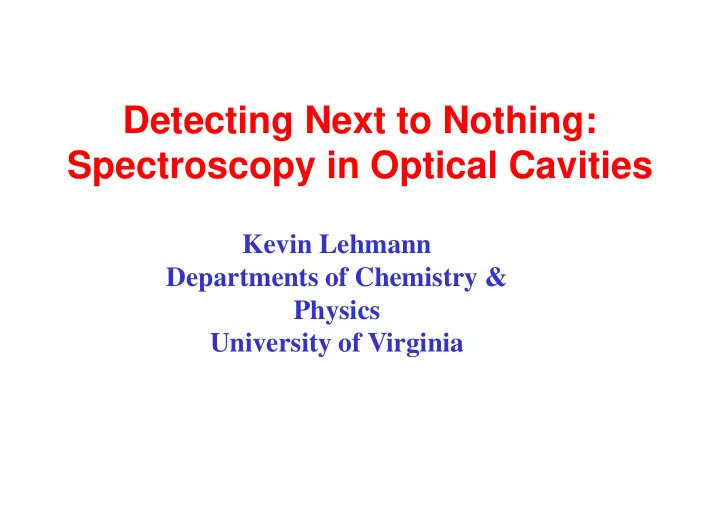

Detecting Next to Nothing: Spectroscopy in Optical Cavities Kevin Lehmann Kevin Lehmann Departments of Chemistry & Physics University of Virginia Cavity Ring Down Spectroscopy
Collaborators • Daniele Romanini • Peter Tarsa • Joan Gambogi • Iris Scheele • John Dudek • Haifeng Huang (UVa) • Greg Engel • Paul Johnston (UVa) • Wilton Virgo • Paul Rabinowitz Wen-Bin Yan, Calvin Kruzen, Bob Augustine, Chris Wu, Yu Chen, Lisa Bergson Cavity Ring Down Spectroscopy
Generic Absorption Spectroscopy Instrument L L Lock-In Lock-In DAS Source Filter Sample Chopper Detector Cavity Ring Down Spectroscopy
Beer’s Law • I out ( ν ) = I in ( ν ) exp ( - σ(ν) N L) − σ(ν ): Absorption cross section – N: Number density of absorber – N: Number density of absorber (Concentration) – L: Optical pathlength through sample Minimum Detectable Concentration: • N min = ( ∆ I/I) min / ( σ(ν) L) Cavity Ring Down Spectroscopy
Review of Optical Cavities (aka etalons) (aka etalons) Cavity Ring Down Spectroscopy
Simple Linear Optical Cavity detector Radii of Curvature: R 1 , R 2 Length of Cavity: L Length of Cavity: L Mirror Transmission: T Mirror Reflectivity: R Mirror Loss: A = 1 - R - T Cavity Ring Down Spectroscopy
Stable Optical Cavities • For R = 1, modes exist which exactly reproduce themselves upon round trip. • 0 < L < R 1 or R 2 < L < R 1 +R 2 (R 1 < R 2 ) – If R 2 - R 1 , << L, then R 1 < L < R 2 only weakly unstable • Optic axis defined by line through centers of curvature of • Optic axis defined by line through centers of curvature of mirrors • Light rays will oscillate around optic axis. • Spot size of mirror ���������������������������������������������������������������������������������������������������������������������������������������������������������������������������������������������������������������������������������������������������������������������������� Cavity Ring Down Spectroscopy
Cavity Transmission as function of Mirror Reflectivity ���������������������������������������������������������������������������������������������������������������������������������������������������������������������������������������������������������������������������������������������������������������������������� ���������������������������������������������������������������������������������������������������������������������������������������������������������������������������������������������������������������������������������������������������������������������������� ���������������������������������������������������������������������������������������������������������������������������������������������������������������������������������������������������������������������������������������������������������������������������� ��������������������������������������������������������������������������������������������������������������������������������������������������������������������������������������������������������������������� � ������������������������������������������������������ Ring-down Time Cavity Ring Down Spectroscopy
���������������������������������������������������������������������������������������������������������������������������������������������������������������������������������������������������������������������������������������������������������������������������� Peak Transmission of Cavity ������������������������������������������������������������������������������������������������������������������������������������������������������������������������������ � ��������������������������������������������������������������������������������������������� Peak Intracavity Gain Mirrors with T,A ~ 5 ppm are available in near IR and red Intracavity power gain of ~10 5 can be realized Cavity Ring Down Spectroscopy
Transverse resonance modes of Cavities ���������������������������������������������������������������������������������������������������������������������������������������������������������������������������������������������������������������������������������������������������������������������������� ���������������������������������������������������������������������������������������������������������������������������������������������������������������������������������������������������������������������������������������������������������������������������� If δ g = M/N, then we have rational cavity with periodic transmission spectrum. Arbitrary pulse inside Cavity will exactly reshape after N round trips -- such cavities are used for Herriott Cells. Cavity Ring Down Spectroscopy
Recommend
More recommend